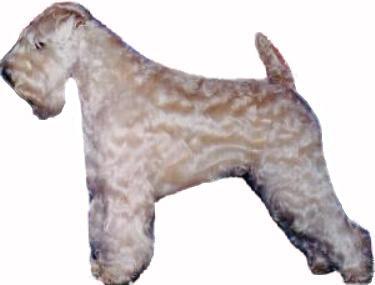
The A.K.C Soft Coated Wheaten Terrier Standard Says....

General AppearanceThe Soft Coated Wheaten Terrier is a medium-sized, hardy, well balanced sporting terrier, square in outline. He is distinguished by his soft, silky, gently waving coat of warm wheaten color and his particularly steady disposition. The breed requires moderation both in structure and presentation, and any exaggerations are to be shunned. He should present the overall appearance of an alert and happy animal, graceful, strong and well coordinated. Size, Proportion, SubstanceA dog shall be 18 to 19 inches at the
withers, the ideal being 18-1/2. A bitch shall be 17 to
18 inches at the withers, the ideal being 17-1/2. Major
Faults-Dogs under 18 inches or over 19 inches; bitches
under 17 inches or over 18 inches. Any deviation must be
penalized according to the degree of its severity. HeadWell balanced and in proportion to the
body. Rectangular in appearance; moderately long.
Powerful with no suggestion of coarseness. Neck, Topline, BodyNeck medium in length, clean and strong, not throaty. Carried proudly, it gradually widens, blending smoothly into the body. Back strong and level. Body compact; relatively short coupled. Chest is deep. Ribs are well sprung but without roundness. Tail is docked and well set on, carried gaily but never over the back. ForequartersShoulders well laid back, clean and smooth; well knit. Forelegs straight and well boned. All dewclaws should be removed. Feet are round and compact with good depth of pad. Pads black. Nails dark. HindquartersHind legs well developed with well bent stifles turning neither in nor out; hocks well let down and parallel to each other. All dewclaws should be removed. The presence of dewclaws on the hind legs should be penalized. Feet are round and compact with good depth of pad. Pads black. Nails dark. CoatA distinguishing characteristic of the
breed which sets the dog apart from all other terriers.
An abundant single coat covering the entire body, legs
and head; coat on the latter falls forward to shade the
eyes. Texture soft and silky with a gentle wave.
In both puppies and adolescents, the mature wavy coat is
generally not yet evident. Major Faults-Woolly or
harsh, crisp or cottony, curly or standaway coat; in the
adult, a straight coat is also objectionable. ColorAny shade of wheaten. Upon close examination, occasional red, white or black guard hairs may be found. However, the overall coloring must be clearly wheaten with no evidence of any other color except on ears and muzzle where blue-gray shading is sometimes present. Major Fault-Any color save wheaten. Puppies and Adolescents-Puppies under a year may carry deeper coloring and occasional black tipping. The adolescent, under two years, is often quite light in color, but must never be white or carry gray other than on ears and muzzle. However, by two years of age, the proper wheaten color should be obvious. GaitGait is free, graceful and lively with good reach in front and strong drive behind. Front and rear feet turn neither in nor out. Dogs who fail to keep their tails erect when moving should be severely penalized. TemperamentThe Wheaten is a happy, steady dog and shows himself gaily with an air of self-confidence. He is alert and exhibits interest in his surroundings; exhibits less aggressiveness than is sometimes encouraged in other terriers. Major Fault-Timid or overly aggressive dogs. |
I purposely highlighted the comments on coat in the standard....


Dog A on
the left - Dog B on the right.
How would you describe the coat on dog A? How
about the coat on dog B?
Remember, the standard says: "Texture
soft and silky with a gentle wave".
Dog A while currently is being
campaigned to his American championship had a judge at a recent
AKC show withhold the first place ribbon due to his
"untypical coat".
Dog B is an AKC Champion.
Dog A coat is still very rare in the AKC ring but is highly desirable and close to ideal. Since Dog B coat is the most common coat type, a handful of judges may mistake prevalence for correct type. So what this misguided judge felt was an untypical coat on Dog A in fact represents typical coat albeit rare. Judges must be able to recognize correct coat.
[Wheaten Points of Interest] [Searching for a Puppy] [PLN/PLE information] [Take a look at a few Lechaun Kids] [Meet Us] [Charlie's Page] [Guest Photo Album] [A Wheaten is...] [Wheaten Chat Room] [How to Subscribe to Wheaten-L]